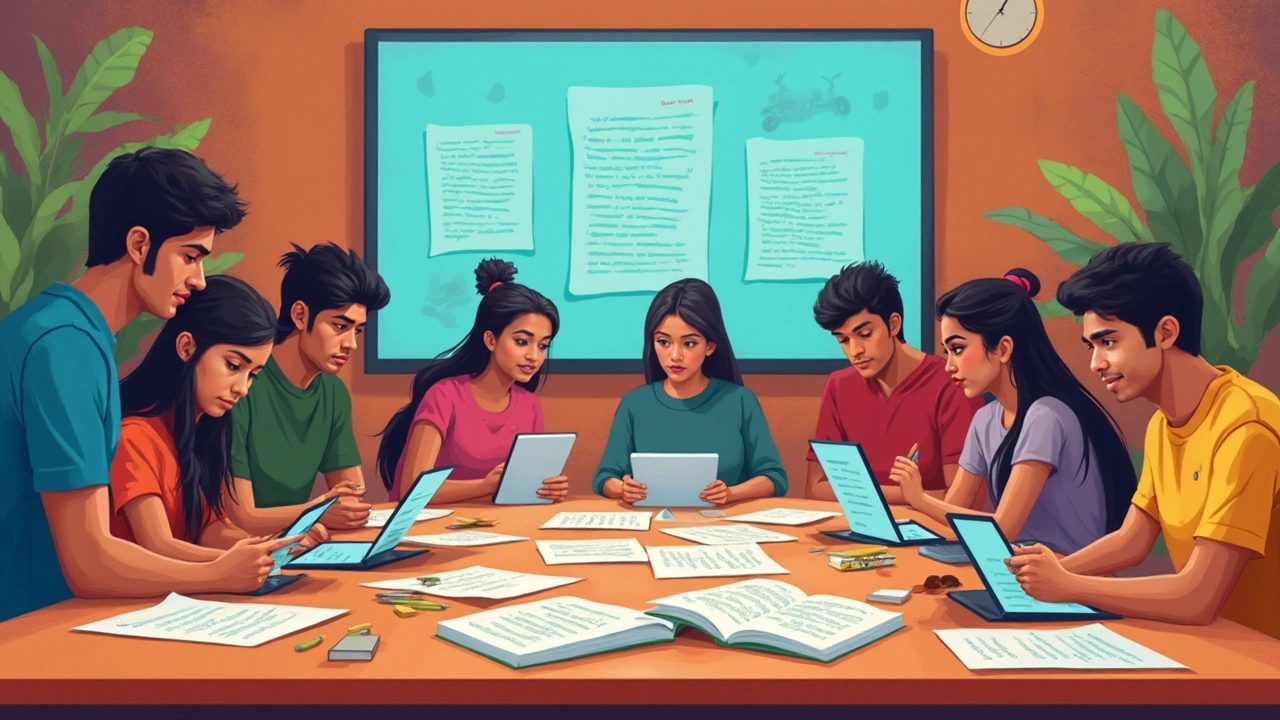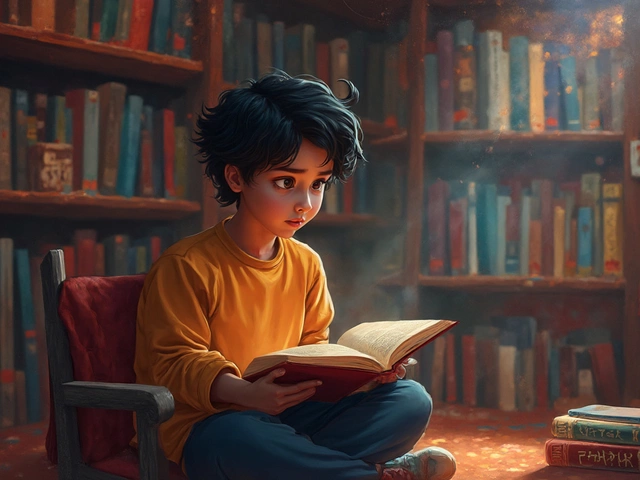
Swiping through a story on your phone while waiting in line—yep, that's modern reading. Forget the idea that reading has to happen with a paper book in your lap. Screens of all sizes have become our new pages, and we're using them to read everything from favorite novels to mind-blowing articles and even minute-long updates on social media apps.
People are squeezing reading into every spare minute, hopping between ebooks, news feeds, and audiobooks—sometimes all in the same day. The pace is brisk, the formats keep changing, and the way we remember and process info has to keep up. Want to make the most of these new trends? It helps to know what’s changing so you can find the reading style that fits your life best.
- What Counts as the New Type of Reading?
- Why Are People Shifting Their Reading Habits?
- Screens, Apps, and Audiobooks: What’s Popular Now
- Is Digital Reading Better or Worse for Us?
- How to Upgrade Your Own Reading Style
What Counts as the New Type of Reading?
If you think new reading just means using an e-reader, think bigger. The landscape’s changed so much in the last five years that even reading a string of texts, skimming Tweets, or listening to audiobooks on your commute all fit the bill. Basically, if you’re absorbing words through a phone, tablet, laptop, or even a smartwatch, you’re part of the new wave.
This new way of digital reading isn’t about one tool or device. It’s about the freedom to jump between formats—swapping from a Kindle novel, to an interactive web comic, to a chain of news updates—without missing a beat. Readers don’t just passively take in info; they click links, highlight text, tap to look up definitions, and sometimes even join online comment threads to share reactions.
- Scrolling and Skimming: People now read in short bursts—whether it’s headlines on news apps or quick summaries in group chats.
- Interactive Reading: Think "choose your own adventure" ebooks, or articles with pop-up explanations and videos.
- Listening is Reading: Audiobooks and podcasts about books are huge. The Audio Publishers Association saw audiobook sales jump almost 45% over four years.
- Social Reading: Apps like Wattpad or Goodreads turn reading into a group effort, with real-time comments and recommendations.
- Bite-Sized Learning: Microlearning platforms and flashcard apps are designed for people who only have a few minutes to read at a time.
Check out this side-by-side look to see how things stack up now:
| Traditional Reading | New Type of Reading |
|---|---|
| Printed books | Ebooks, phone screens, smart devices |
| Focused, start-to-finish reading | Jumping between formats and devices |
| Solitary experience | Social interaction and instant sharing |
| Few formats | Audio, visual, interactive, bite-sized |
When people talk about the new reading, they mean all the creative, digital ways we consume stories and info today. So whether you like a podcast summary or a graphic novel app, you’re doing it right.
Why Are People Shifting Their Reading Habits?
People aren't just reading differently—they're reading more often and in more places, thanks to technology. The main driver? Convenience. You don’t need to pack three heavy books for a commute when your phone can hold thousands of digital reading options. Most folks jump between reading formats based on where they are and what they’re doing.
Mobile reading is huge now. In early 2024, a Pew Research Center study found that over 55% of U.S. adults used a smartphone or tablet as their main way to read news or books. That’s a pretty serious shift from a decade ago, where print and desktops ruled. Audiobooks aren’t just for road trips anymore—you’ll see people listening while walking the dog or cooking dinner.
Another big reason for the shift is time, or the lack of it. Life just feels busier. Short, bite-sized articles and story formats fit the time people actually have. Platforms like TikTok and Instagram even experiment with quick, text-based stories that can be read in under a minute.
Here are a few real-world reasons behind the change:
- Digital reading is easy to access anytime, anywhere.
- Library apps like Libby and Kindle Unlimited offer thousands of free or cheap books right on your phone.
- People like to customize the reading experience—changing font sizes, using dark mode, or switching to audio when their eyes are tired.
- Recommendations are everywhere, so you never run out of ideas for what to read next.
The payoff? People are reading more overall, just in smaller bites and new ways. The traditional book isn’t disappearing, but the habits around new reading are getting shaped by what’s easy, quick, and fits in with everything else going on in life.

Screens, Apps, and Audiobooks: What’s Popular Now
Want to know what everyone's actually using to read these days? It’s not just old-fashioned books. People are glued to screens and using all kinds of digital reading platforms. E-readers like Kindle are still going strong because you can store thousands of books on one lightweight device. But reading on your phone has exploded. Apps like Kindle, Apple Books, and even Google Play Books let you jump into stories anytime, anywhere—as long as you have your phone on you (which, let’s face it, is always).
Social reading apps take things up a notch. Platforms like Wattpad and Webtoon let readers dive into stories written by users just like them. A lot of these stories are released chapter by chapter, so you keep coming back for updates. Even TikTok has become a hub for book lovers—search #BookTok and you'll find quick reviews, recommendations, and even authors talking about their own work. These communities are shaping what goes viral in the book world right now.
Audiobooks are another huge part of the new reading crowd. About one in four readers listened to at least one audiobook last year, according to a survey by the Audio Publishers Association. Services like Audible, Scribd, and Spotify now let you stream or download books to listen to in the car, at the gym, or on a walk. Lots of folks say audiobooks help them "read" more because they can multitask. No surprise—some bestsellers see more listeners than physical book buyers.
| Platform | Type | Key Feature |
|---|---|---|
| Kindle | Ebook | Huge library, customizable fonts |
| Wattpad | Story App | User-written content, social features |
| Audible | Audiobook | Massive audio book library, subscriptions |
| #BookTok | Social Media | Book recommendations, trends |
Short-form reading is another wild trend. Apps like Blinkist or Headway break down non-fiction books into quick summaries you can read in about 15 minutes. These are popular with busy people who want key info fast without reading a whole book. If you're always scrolling, apps like Pocket and Instapaper let you save articles to read later, turning "dead time" into productive reading time.
So whether you’re into old-school ebooks, want the chit-chat of social reading, or like to power through stories with your headphones on, there's never been more ways to fit new reading habits into your life. The most popular options make reading quicker, more social, and sometimes even more fun.
Is Digital Reading Better or Worse for Us?
The big question everyone asks: is this new reading actually good? Well, it’s not a simple yes or no. Digital reading offers handy features, like adjustable fonts, built-in dictionaries, and the power to carry thousands of books in your pocket. But it also brings its own set of challenges, and some of them are harder to ignore.
For example, researchers at Stanford found that people reading on paper generally remember more details than those reading on a screen, especially if they're trying to follow a complex story. It's just easier for our brains to navigate paper, probably because you can flip pages and spot your place without thinking. But that doesn't mean digital reading is always worse. Ebooks and online articles let you highlight, search, and share stuff instantly—a win for most of us juggling busy schedules.
When it comes to health, eyeballs deserve some sympathy. Staring at screens for long stretches can lead to digital eye strain. Symptoms include headaches, tired eyes, and even blurred vision. The American Optometric Association has a simple tip: follow the 20-20-20 rule. Every 20 minutes, look at something 20 feet away for 20 seconds. Old-school advice, but it works.
Attention is another biggie. Notifications, ads, and pop-ups can wreck your focus. Multitasking while reading rarely ends well—switching between a book and Instagram just guarantees you’ll forget half of what you read. Turning on “Do Not Disturb” or using dedicated reading apps helps you stay dialed in.
Still, digital reading has led to more people picking up new reading habits. A survey in 2024 showed that over 60% of adults read online articles weekly, and more than half of Gen Z prefer ebooks or webtoons over printed books.
| Format | Info Retention | Eye Strain |
|---|---|---|
| Print Books | High | Low |
| Ebooks | Medium | Medium |
| Articles on Phone | Variable | High (if long) |
The truth is, each method has pros and cons. If you want to remember details, paper is still king. If you value convenience and flexibility, digital wins hands down. The best move? Mix things up—grab a paperback when you care about the story, and lean on ebooks and apps when you want quick info or need something on the go.

How to Upgrade Your Own Reading Style
If you want to keep up with the new reading trends, it’s all about mixing up your habits and trying fresh tools. You don’t need to dump your favorite paperbacks, but adding some digital tricks and routines can help you read more (and maybe even enjoy it more).
First, try different digital reading platforms. Ebooks, web apps like Pocket, and news aggregators like Feedly offer tons of reading material on the go. If you’re the type who never finds time to sit down with a book, audiobooks are game changers. According to Edison Research, audiobook sales hit a record high in 2024, with over 48% of adults in the US listening to at least one audiobook last year.
Here’s a quick table showing how readers are splitting their time:
| Format | Percent of Readers (2024) |
|---|---|
| Ebooks | 34% |
| Audiobooks | 48% |
| Print Books | 53% |
| Short-form Content (apps, feeds) | 61% |
Want to read more without burning out? Try these tips:
- Mix long reads and short-form articles. Don’t feel guilty about reading a news roundup instead of another 400-page novel.
- Use apps to set reading reminders. Kindle and Scribd let you set daily goals so you turn reading into a habit, even if it’s just 10 minutes a day.
- Try different genres and formats. Some stories just flow better as an audiobook or with interactive graphics.
- Don’t just scroll—engage! Highlight, take notes, or share quotes on social media. It helps you remember and enjoy what you’re reading.
- If your eyes get tired, change your screen’s display. Try dark mode or increase font size—little tweaks that make digital reading much friendlier.
Switching it up with new tech and platforms can make reading less of a chore and more of a habit you look forward to. Plus, discovering what works for you is half the fun. The way you read should fit your life, not the other way around.


